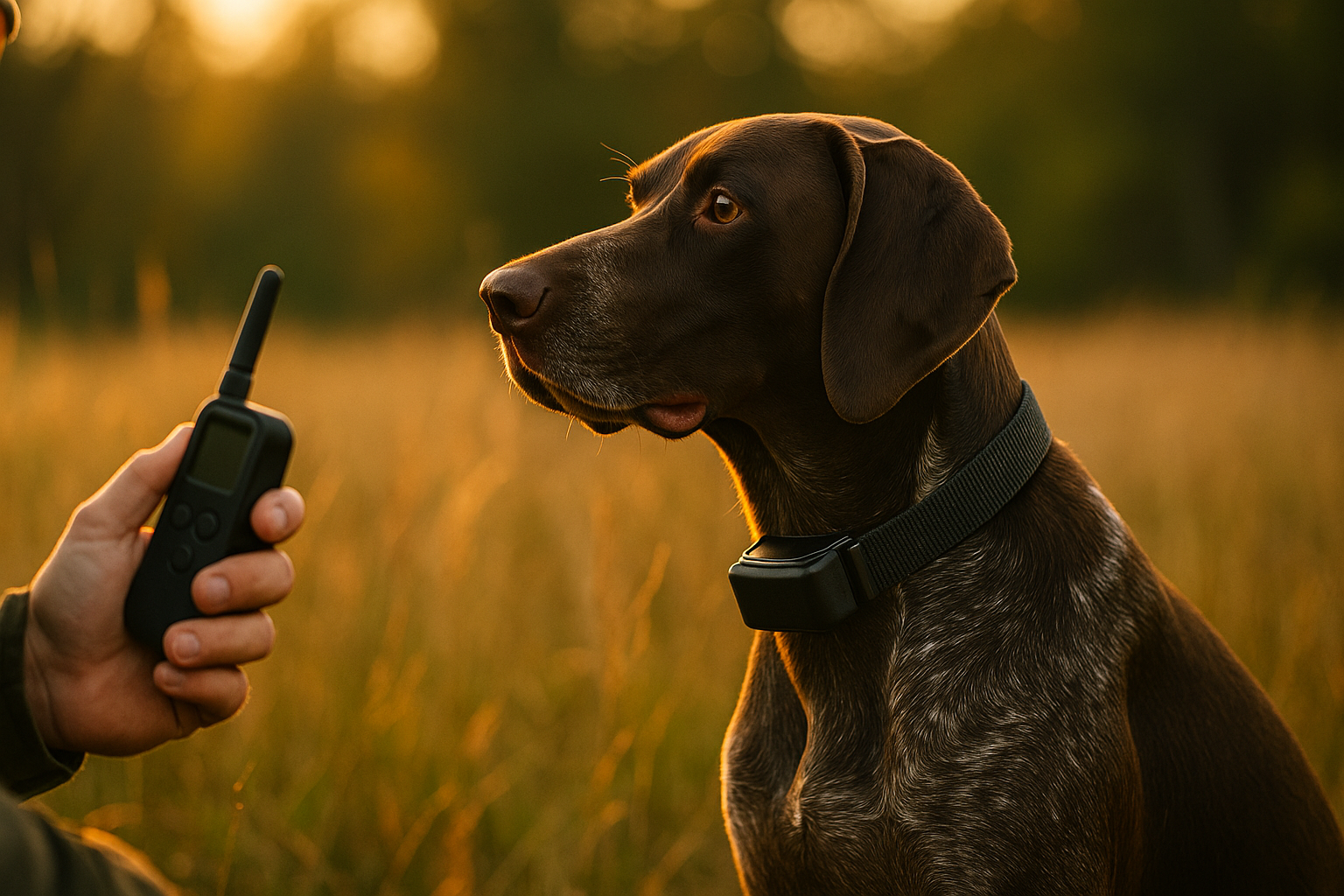
If you’ve ever yelled “leave it!” and your dog heard “do a zoomie,” this guide’s for you. We field-tested and sanity-checked 10 remote trainers—from pro-grade Garmin/Dogtra/Educator to reliable mainstream picks—so you know exactly what you’re buying and why.
Quick answer
-
If you want pro-grade with a gentle ramp: Educator ET-300 Mini (½-mile, super precise). Amazon
-
If you need serious range & authority for big dogs: Educator ET-800 “The Boss” (1-mile). Amazon
-
If you want a rugged, one-hand dial: Garmin Sport PRO (¾-mile, BarkLimiter, floats). Amazon
-
If you want simple 3-button training: Garmin Delta SE (½-mile). Amazon
-
Best mainstream yard/field trainer: SportDOG 425X (500-yd; 21 levels). Amazon
-
Half-mile step-up: SportDOG 825X (½-mile; 21 levels). Amazon
-
Workhorse for medium/large dogs: Dogtra 1900S (¾-mile; low-to-high output). Amazon
-
Low-profile receiver: Dogtra ARC (¾-mile; slim curved receiver). Amazon
-
GPS + training in one: Dogtra Pathfinder 2 (tracking, geo-fence + stim). Amazon
-
Budget-friendly, entry yard range: PetSafe 300 Yard (tone/vibe/15 levels). Amazon
How to choose
-
fit & contact (short vs long points; snug two-finger rule).
-
range (yard: 100–500 yd; field/hunt: ½–1 mile).
-
water rating (IPX7 or submersible is ideal).
-
controls (no-look dial vs buttons).
-
stimulation window (more levels = finer control).
-
training plan (pair with markers/treats; stim = last resort, not first).
Safety & humane use
-
Start with tone or vibration as attention-getters.
-
If you use static, start at the lowest perceivable level and only to interrupt, not punish.
-
Keep sessions short, collars rotated every few hours to avoid skin irritation, and remove when not training. (Most brands advise ≤10–12 hrs/day.)
Educator ET-300 Mini
The darling of balanced trainers: a compact handset with a big “control window” (100 levels) so you can land on just enough stimulation without spooking a sensitive dog. The receiver’s small, the remote floats, and momentary/continuous give you nuance in real time. If you pair stim with a marker (“Yes!”) and paychecks (treat/toy), the ET-300 becomes a quiet line of communication—more nudge than “shock.”
Pros (green)
- 100 levels = ultra-fine control
- ½-mile range; waterproof; floating remote
- Tone, vibration, momentary & continuous
Cons (red)
- Single-dog out of box (expand via second receiver on other models)
- Learning curve if you’ve only used cheap remotes
Best for: obedience, off-leash recall, sensitive to medium-drive dogs.
Not for: handlers who truly need 1-mile range.
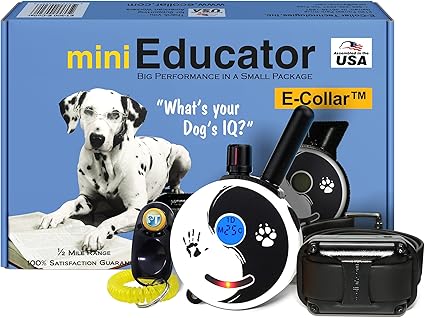
Educator ET-800 “The Boss”
Big dogs with big opinions? This is the hammer you almost never swing. Same nuanced 1–100 level control, but with the headroom to reach large, hard-charging dogs through heavy coats or high arousal. The handset floats, the receiver is tough, and you can run it in vibe/tone for 90% of work—static is just a last-ditch exclamation mark.
Pros
- 1-mile range; serious output ceiling
- Floating remote; night tracking light
- Assembled/tested in USA
Cons
- Overkill for small/sensitive dogs
- Pricier than mid-range sets
Best for: big working breeds, protection sports, waterfowl/off-lead fieldwork.
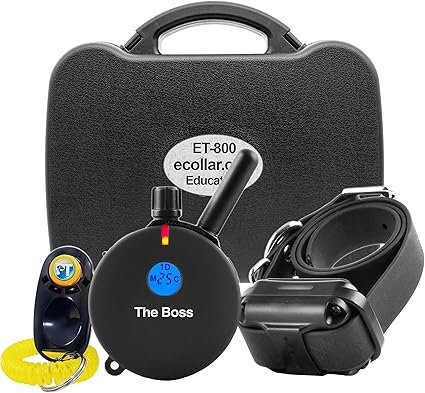
Garmin Sport PRO Bundle
Hunter’s favorite for a reason: no-look dial with positive clicks, BarkLimiter, remote-controlled beacon lights, and a handset that floats. The interface is predictable even with gloves on. If you run multiple dogs, the toggle and color-coded buttons are a dream.
Pros
- ¾-mile range; BarkLimiter built in
- LED beacons; handset floats
- Intuitive one-hand control
Cons
- 10 levels—less granular than Educator/Dogtra
- Garmin pricing—worth it, but not “budget”
Best for: sporting/hunting, multi-dog work, glove-weather training.
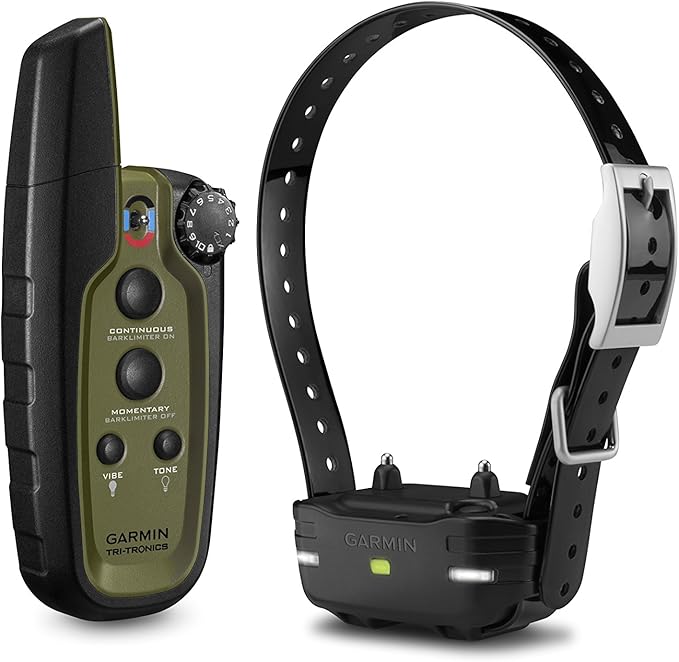
Garmin Delta SE
Keep it simple. The Delta SE gives you the Garmin build, a tactile dial, and tone/vibe/stim with a half-mile of leashless freedom. If you want “less screen, more dog,” this is it—especially for first-time e-collar users who still want premium hardware.
Pros
- Clean 3-button layout; easy to learn
- ½-mile range; IPX7-style ruggedness
- Tone and vibration on tap
Cons
- Not as many levels as Dogtra/Educator
- Fewer “pro” toggles than Sport PRO
Best for: first e-collar, handlers who want fewer controls.
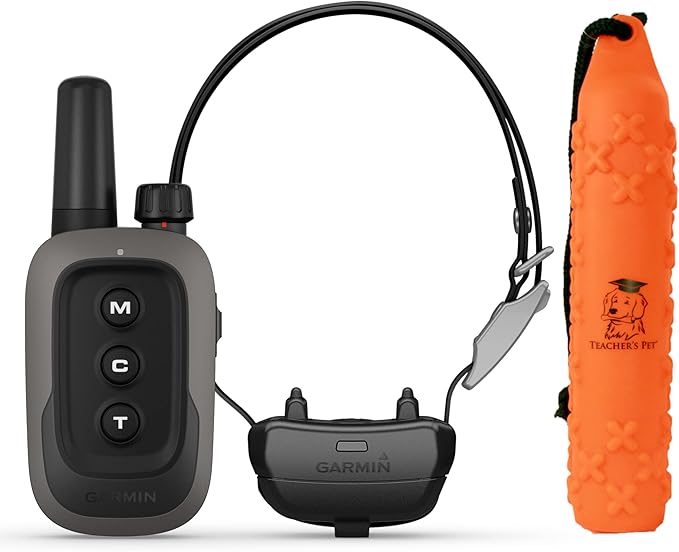
SportDOG 425X
SportDOG keeps it straightforward: a compact handset, 21 levels, and DryTek waterproofing (submersible to 25 ft). It’s a true “yard + close field” tool, and the ergonomics are built for no-look operation—dial and click. If you later need more reach, jump to the 825X.
Pros
- 500-yd range; 21 levels
- Submersible to 25 ft
- No-look dial operation
Cons
- Shorter range than 825X/1900S
- Battery life is good, but not class-leading
Best for: yard to short field training; beginners who want solid hardware.
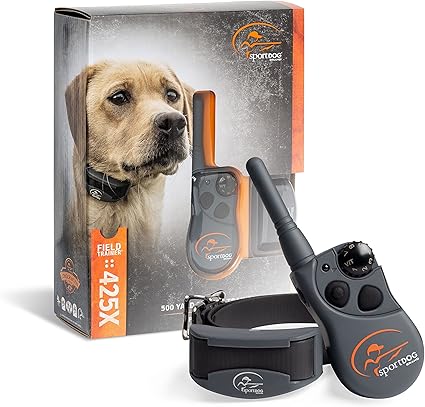
SportDOG 825X
Think of the 825X as the 425X’s bigger brother: same interface, more reach (½-mile) while staying compact. Great pick if your training happens across fields or open space where 500 yards can come fast.
Pros
- ½-mile range; 21 levels
- Rugged, glove-friendly interface
- Multi-dog capable
Cons
- Still less granular than Dogtra/Educator
- No GPS/bark features (pure trainer)
Best for: upland prep, large parks/fields.
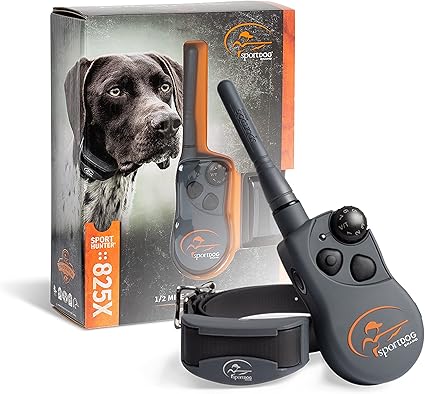
Dogtra 1900S
The 1900S is a pro workhorse: 0–127 levels on a smooth rheostat dial for needle-point precision, ¾-mile range, and a waterproof, tough receiver. The handset is simple—no gimmicks—so your eyes stay on the dog. If you need a single do-everything collar for medium/large dogs, this is it.
Pros
- 0–127 levels = ultra-granular
- ¾-mile range; waterproof
- Trusted by working-dog handlers
Cons
- Remote UI is minimalist (great for pros, some beginners prefer screens)
- Single-dog system out of box
Best for: medium/large dogs, fieldwork, precise low-level work.
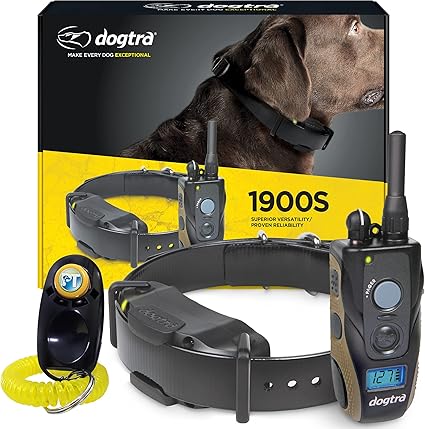
Dogtra ARC
Same Dogtra DNA, but the ARC curves to the dog’s neck for a lower profile (nice for sleek-coated or camera-shy dogs). You keep the 0–127 levels via rheostat and the all-weather build. Excellent for handlers who want the capability of a 1900S without the look.
Pros
- Low-profile, curved receiver
- ¾-mile, waterproof; 0–127 levels
- Great “discreet” look for city training
Cons
- Cost similar to 1900S; decide by receiver shape
- Handset learning curve vs button-only remotes
Best for: handlers prioritizing comfort/looks without losing performance.
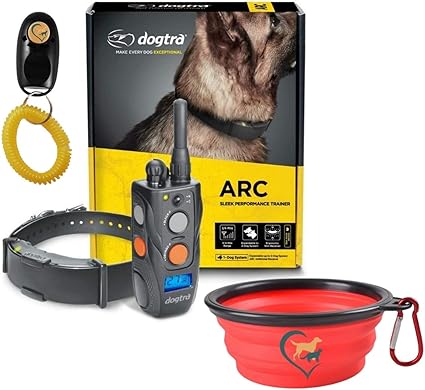
Dogtra Pathfinder 2
This is next-level: a full GPS tracking system with geo-fence and training built-in. You get app-based mapping, long-range comms, and traditional tone/vibe/stim for corrections. For hounds, upland, or rural roamers, it’s a control center—not just a collar.
Pros
- 9-mile tracking + training
- App maps & geo-fence tools
- Great for hunting/multi-dog setups
Cons
- Pricey; overkill for suburban yard work
- App learning curve
Best for: hunters, rural off-leash, multi-dog tracking.
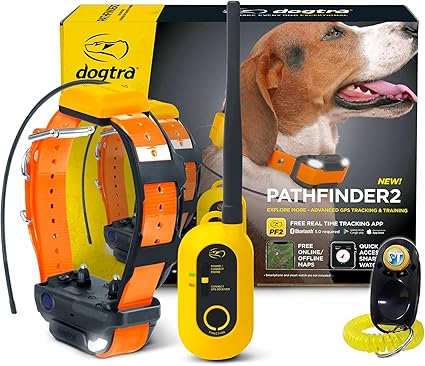
PetSafe 300-Yard Remote Trainer
Want something affordable for yard manners with tone, vibration, and 15 stim levels? PetSafe’s 300-yard unit is the classic “dip a toe into e-collars” option. Keep expectations realistic: this is for yard/park range—not a quail field.
Pros
- Budget-friendly, simple
- Tone/vibe + 15 levels
- Rechargeable; waterproof receiver
Cons
- 300 yds = yard/park only
- Less granular than pro units
Best for: first-timer yard manners, suburban recall insurance.
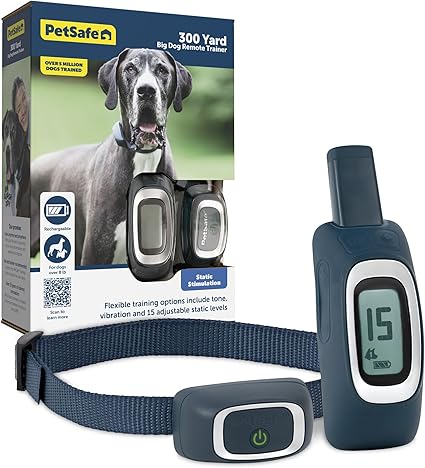
Bonus “close fits” you might consider
-
Dogtra 200C – ultra-compact, ½-mile, 0–100 levels; great starter pro unit. Amazon
-
SportDOG 425XS – higher output version of 425X for stubborn dogs. Amazon
Real-world sizing & fit (don’t skip)
-
Contact points: use short for short coats, long for thick/double coats; swap if you’re not getting consistent response at low levels.
-
Collar placement: park the receiver at 4–5 o’clock on the neck, snug enough that the contact points don’t drift when the dog trots or shakes.
-
Rotation: move position each session; check skin daily. (Brands advise ≤10–12 hrs/day wear.)
FAQs
Is static “shock” safe? Used correctly at the lowest perceivable level and paired with positive reinforcement, modern e-collars are tools—not punishers. All units above include tone/vibration to reduce reliance on static. (Follow each brand’s skin-care and wear-time guidance.)
Yard vs field range? 300–500 yds is yard/park. ½–¾ mile covers most field work. 1 mile is pro-range or big-country insurance. See the ET-800 and 1900S for high-range options.
Waterproofing? Look for IPX7/submersible (SportDOG DryTek to 25 ft, many Garmins float).
Final thoughts
A good e-collar isn’t a shortcut; it’s a seatbelt for communication. The magic isn’t in the box—it’s in your timing, your marker words, and your consistency. Start every session with a plan, lead with tone/vibration, and if you ever touch static, keep it at the lowest perceivable nudge—a whisper that cuts through the world, not a shout that drowns it out. Your dog should look more curious and tuned-in after a correction, not worried or confused. When in doubt, step down a level, sweeten the paycheck, and try again.
Match the tool to the job, then practice like you mean it. If you want one do-almost-everything unit with great finesse, the Educator ET-300 is tough to beat. Big dog and big country? The ET-800 gives you the headroom. Need glove-proof controls and multi-dog simplicity? Garmin Sport PRO is the no-look classic. Yard manners on a budget? PetSafe 300-Yard keeps it simple. Prefer low-profile hardware? Dogtra ARC. Want GPS with training baked in? Dogtra Pathfinder 2. Pick the right lane—and then drive it well.
Most of all, keep sessions short, end on a win, and protect the relationship. If your dog powers up when they see the collar, you’re doing it right. If they power down, slow down. Train the brain first; your thumb is just the translator. Now go make some reps count.